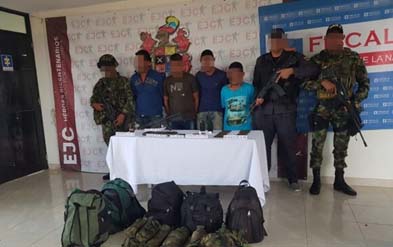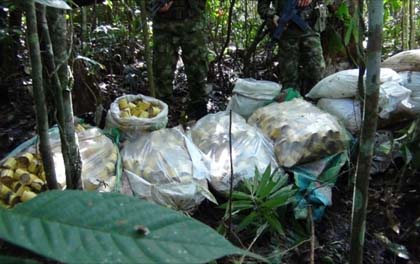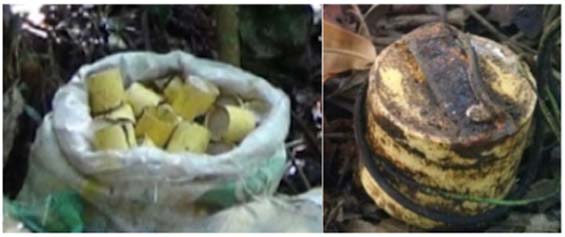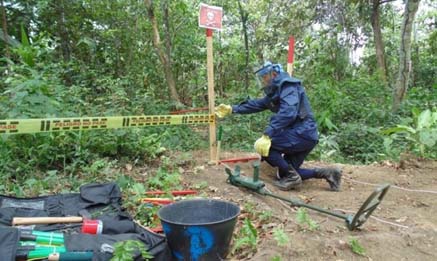Third Generation Gangs Strategic Note No. 17: Antipersonnel Landmine Use and Fabrication by the Clan del Golfo in Colombia
John P. Sullivan and Robert J. Bunker
Over the last few months, Colombian army and police have discovered factories operated by the Clan del Golfo engaged in producing and stockpiling antipersonnel mines and explosive devices. In addition, cases of Colombian soldiers sustaining injuries from antipersonnel mines have been documented. These cases illustrate the ongoing, and apparently growing, threat—initially disclosed in an alert made by the Colombian Army in May 2013—of antipersonnel mines employed by criminal organizations or bandes criminals (criminal bands or bacrim).[1]

Colombian National Army captures four alleged Clan del Golfo members during humanitarian demining operation in April 2019. Source: Séptima División del Ejército Nacional de Colombia.
Key Information: José David Escobar Moreno, “Alerta por las fábricas de minas antipersonales del Clan del Golfo.” El Espectador. 9 June 2019, https://www.elespectador.com/noticias/judicial/alerta-por-las-fabricas-de-minas-antipersonales-del-clan-del-golfo-articulo-865069:
La destrucción de dos instalaciones del grupo criminal para fabricar estos letales artefactos ha prendido las alarmas de la Fuerza Pública y de organizaciones como la Cruz Roja Colombiana. A lo largo de este año ya van 59 víctimas de estos dispositivos.
Key Information: “Clan del Golfo fabrica minas antipersona en Antioquia.” Caracol Radio. 5 June 2019, https://caracol.com.co/emisora/2019/05/04/medellin/1557006465_526881.html:
En operativos de las últimas horas el Ejército Nacional encontró un campamento en la vereda Flechas, norte de Antioquia, que era usado para planear y lanzar acciones terroristas en contra de la población civil y la fuerza pública.
De acuerdo a las autoridades, en ese lugar 40 personas pertenecientes al Clan del Golfo eran los encargados de producir minas antipersonal y artefactos explosivos que posteriormente serían ubicadas en las zonas donde avanza la Campaña Militar y Policial Aquiles.
Key Information: Olga Patricia Rendón Marulanda, “Clan del Golfo tenía listas 563 minas antipersonal, Ejército las encountró,” El Colombiano. 22 May 2019, https://www.elcolombiano.com/colombia/paz-y-derechos-humanos/clan-del-golfo-tenia-listas-minas-antipersonal-y-el-ejercito-las-encontro-ho10789871:
El Ejército logró en las últimas horas la ubicación de un sitio destinado a la fabricación de minas antipersona y artefactos explosivos, en el cual ya tenían listas 563 para ser instaladas y que de acuerdo a informaciones estas pertenecían al Clan del Golfo.
De acuerdo con esa institución, el hallazgo se produjo en la vereda Consejo Mayor zona rural de Riosucio al norte del Chocó, en límites con el Urabá antioqueño. “Allí fue ubicado el sitio donde miembros de la subestructura Roberto Vargas Gutiérrez del Clan del Golfo elaboraban y escondían estos mortales artefactos, para luego ser enviados e instalados en diferentes lugares para atentar contra la población civil y la fuerza pública”, dice el comunicado de la Séptima División del Ejército.

Antipersonnel mines alleged to have been produced and stockpiled by the Clan del Golfo seized by Colombian Army in May 2019. Source: Séptima División del Ejército Nacional de Colombia.
Key Information: “Cinco uniformados del Ejército resultaron heridos por mina antipersona en Tarazá, Antioquia.” Noticias RCN. 12 May 2019, https://noticias.canalrcn.com/nacional-pais/cinco-uniformados-del-ejercito-resultaron-heridos-mina-antipersona-taraza-antioquia:
Cuatro soldados y un teniente resultaron heridos en la tarde de este domingo en la vereda Montañita en zona rural de Tarazá, en el Bajo Cauca antioqueño, al activar un área minada presuntamente por las disidencias del frente 18 de las Farc.
En esa zona de Antioquia confluyen varios grupos armados organizados: el Clan del Golfo, los Caparrapos y las disidencias de las Farc, y actúa la Fuerza de Tarea Conjunta Aquiles, con más de 6.000 hombres del Ejército, la Armada, la Fuerza Aérea y la Policía.
Key Information: “El Ejército denunció la instalación de minas antipersonal por parte del Clan del Golfo.” Urabá. 29 April 2019, https://uraba.net/2019/04/29/el-ejercito-denuncio-la-instalacion-de-minas-antipersonal-por-parte-del-clan-del-golfo/:
En la zona rural del municipio de Puerto Libertador, sur de Córdoba, donde desde hace más de un mes se presenta una difícil situación humanitaria por los desplazamientos masivos de civiles que han generado los enfrentamientos entre grupos armados ilegales.
Afirma la Séptima División que en la vereda Santa Rosa del mencionado municipio “los uniformados llegaron a varios puntos donde lograron neutralizar cuatro minas antipersonal, que habían sido instaladas por la subestructura Rubén Darío Ávila, del Clan del Golfo con el objetivo de atentar contra la población civil”.
Agrega esa institución que los explosivos habían sido puestos en caminos veredales que normalmente usa la comunidad para sus desplazamientos diarios. Incluso, el pasado jueves se registró un incidente con una mina antipersonal, cuando un menor de edad perdió uno de sus pies al activar ese explosivo mientras caminaba por la vereda La Flecha, zona limítrofe de los municipios de Puerto Libertador e Ituango.
Third Generation Gang Analysis
Colombia’s Clan del Golfo (Gulf Clan) is an organized paramilitary criminal organization. The Clan del Golfo emerged in 2007-2008 after the demobilization of the Autodefensas Unidas de Colombia or AUC (United Self-Defense Forces of Colombia)[2] left a void in Colombia’s criminal landscape.[3] The group is also known as Los Urabeños, the Clan Úsuga, or the Autodefensas Gaitanistas de Colombia (AGC).[4] The group is active in between 17-22 of Colombia’s departments. It is especially active around the Gulf of Urabá in the departments of Antioquia and Chocó, stretching into Córdoba, and in Medellín, as well as othe departments along the Pacific and Caribbean coasts.[5] The Clan del Golfo is an example of the bandas criminales (bacrim) or criminal bands (paramilitary gangs) that have filled the void in the illicit economy left by the AUC and FARC (Fuerzas Armadas Revolucionarias de Colombia or Revolutionary Armed Forces of Colombia).[6]
The Clan del Golfo is a networked criminal enterprise with strong paramilitary roots. It has leveraged relationships with former guerillas and local gangs to build a constellation of alliances and franchises with smaller gangs throughout Colombia. This fusion of guerillas and drug traffickers (narcos) allows this particular ‘bacrim’ to expand its reach and exert territorial control—including controlling ‘plazas de microtráfico’ (micro-trafficking plazas). According to the Fundación Ideas Para La Paz (FIP): “The AGC [Clan del Golfo] is a criminal network that integrates different organizations — regional criminal structures, drug traffickers, collection offices, gangs, combos — that work under the same name, but that have autonomy in their actions.”[7]
Bacrim/Armed Non-State Actor Use of Anti-personnel Landmines
A number of guerilla and criminal bands (paramilitary gangs or bacrim) have utilized antipersonnel gangs in Colombia’s guerilla wars and now in its crime wars and criminal insurgencies. Bacrim, like the Clan del Golfo, have used antipersonnel mines to control territory, secure their base camps, processing centers, and lines of communication from criminal rivals and state security forces. Mines are thus commonly deployed in foot trails, roadways, and in agricultural fields to deter opposing criminal groups and governmental forces threatening bacrim operations and to restrict and control the movements of local civilians who exist within their spheres of influence. The incidents documented in the key information entries above demonstrate that the Clan del Golfo is now actively using thousands of antipersonnel mines in furtherance of their criminal enterprise(s). In addition, legacy minefields from Colombia’s civil war and various guerilla campaigns persist. They pose risks to security forces (police and military) and civilians alike despite ongoing governmental demining activities.[8] In 2018, for example, at least 113 persons were victims of antipersonnel mines in areas controlled by the Cartel del Golfo, Ejército de Liberación Nacional (ELN or National Liberation Army), or Ejército Popular de Liberación (EPL or Popular Liberation Army).[9]

Image (Left): One of the bags containing 563 antipersonnel mines seized from a clandestine Clan del Golfo (alleged) manufacturing site near Riosucio - Chocó by the Colombian Army in May 2019. Image (Right): A similar improvised 40mm antipersonnel mine deployed by Clan del Golfo. This mine was rendered safe (demined) by the Colombian Army in November 2016 in Granada-Meta. Source: Ejército Nacional de Colombia.[10][11]
Colombia is a state party to the Mine Ban Convention (or Ottawa Treaty) which seeks to end the use of antipersonnel landmines (APLs) worldwide and the Convention on Certain Conventional Weapons (Amended Protocol II).[12][13] The provisions proscribing the use of antipersonnel landmines apply to both international and non-international armed conflicts (NIACs). Specifically state practice considers restrictions on the use of landmines to be a norm of customary international law. All states thus have the responsibility to obviate the indiscriminate effects of antipersonnel landmines.[14] Limiting the spread of APLs to non-state actors is a pressing global concern. This is especially the case in Colombia where the proliferation of anti-personal landmines demands humanitarian action.[15] While non-state armed groups can’t enter into treaties with states, research has shown that they can be encouraged through incentives to abide by international humanitarian norms.[16] Geneva Call, a humanitarian NGO, has been working with armed non-state actors (ANSAs) to voluntarily adhere to humanitarian principles, including forsaking the use of anti-personnel landmines. The armed groups sign ‘deeds of commitment’ pledging to eschew the use of anti-personnel mines. According to Geneva Call: “50 ANSAs have signed the Deed of Commitment banning AP mines and have taken measures to enforce their obligations.”[17][18]

Colombian Army Humanitarian Demining Engineer conducting humanitarian demining operations in Valle de Cauca, 2018. Source: La Brigada de Ingenieros de Desminado Humanitario (BRDEH) del Ejército Nacional de Colombia
Conclusion
Incorporating an awareness of humanitarian demining, as well as education and advocacy for humanitarian mine action principles, is an essential component of addressing the use of anti-personnel landmines in NIACs and related armed criminal campaigns. Even if these conflict environments don’t rise to the level of intensity and organization required to be deemed a NIAC. Police, military, and security forces must incorporate efforts to safely identify and render safe anti-personnel landmines. They must also consider the potential for their use in novel situations (such as the recent use of antipersonnel mines in Mexico),[19] and by new actors (such as bacrim) as seen in Colombia. Military and police demining and bomb squad (explosive ordnance disposal) units should cross-train in areas facing high-intensity crime or potential criminal insurgency.[20] The employment of humanitarian education and norm building, as seen in various humanitarian mine action initiatives, must also become a core element of state response to anti-personnel landmine use in criminal conflicts involving ANSAs.
Sources
“Cinco uniformados del Ejército resultaron heridos por mina antipersona en Tarazá, Antioquia.” Noticias RCN. 12 May 2019, https://noticias.canalrcn.com/nacional-pais/cinco-uniformados-del-ejercito-resultaron-heridos-mina-antipersona-taraza-antioquia.
“Clan del Golfo fabrica minas antipersona en Antioquia.” Caracol Radio. 5 June 2019, https://caracol.com.co/emisora/2019/05/04/medellin/1557006465_526881.html.
“El Ejército denunció la instalación de minas antipersonal por parte del Clan del Golfo.” Urabá. 29 April 2019, https://uraba.net/2019/04/29/el-ejercito-denuncio-la-instalacion-de-minas-antipersonal-por-parte-del-clan-del-golfo/.
José David Escobar Moreno, “Alerta por las fábricas de minas antipersonales del Clan del Golfo.” El Espectador. 9 June 2019, https://www.elespectador.com/noticias/judicial/alerta-por-las-fabricas-de-minas-antipersonales-del-clan-del-golfo-articulo-865069.
Myriam Ortega, “Colombia Makes Progress with Humanitarian Mine Clearance,” Diálogo. 17 September 2018, https://dialogo-americas.com/en/articles/colombia-makes-progress-humanitarian-mine-clearance.
Olga Patricia Rendón Marulanda, “Clan del Golfo tenía listas 563 minas antipersonal, Ejército las encountró,” El Colombiano. 22 May 2019, https://www.elcolombiano.com/colombia/paz-y-derechos-humanos/clan-del-golfo-tenia-listas-minas-antipersonal-y-el-ejercito-las-encontro-ho10789871.
End Notes
[1] Juan Guillermo Mercado, “Bandas criminales siembran minas en varias zonas del país.” El Tiempo. 26 May 2013, https://www.eltiempo.com/archivo/documento/CMS-12825863. For an English summation of this information see James Bargent, “BACRIM Turn to Landmines in Colombia.” InSight Crime. 31 May 2013, https://www.insightcrime.org/news/analysis/bacrim-turn-to-landmines-to-protect-criminal-interests-in-colombia/.
[2] For an excellent overview of the AUC, see: “United Self-Defense Forces of Colombia.” Mapping Militant Organizations. Stanford University, 28 August 2015, https://web.stanford.edu/group/mappingmilitants/cgi-bin/groups/view/85.
[3] “Exclusive: A Look into ‘Clan del Golfo,’ Colombia’s Largest Paramilitary Group.” teleSUR. 2 April 2018, https://www.telesurenglish.net/news/Exclusive-Gulf-Clan-Colombias-Biggest-Paramilitary-Group-20180402-0026.html.
[4] Jarrod Demir, “The rise of the AGC, Colombia’s criminal powerhouse.” Colombia Reports. 19 March 2018, https://colombiareports.com/the-rise-of-the-agc-colombias-criminal-powerhouse/.
[5] Estimates on geographic reach vary. See Notes 1-3 above and “Urabeños.” InSight Crime. 14 March 2018, https://www.insightcrime.org/colombia-organized-crime-news/urabenos-profile/.
[6] See John P. Sullivan, “BACRIM: Colombian Bandas Criminales Emergentes.” The Counter Terrorist, Vol 7, No. 2. April/May 2014, available at https://www.academia.edu/6942753/Bacrim_Colombian_Bandas_Criminales_Emergentes and “Bandas Criminales,” Mapping Militant Organizations. Stanford University, 28 August 2015, https://web.stanford.edu/group/mappingmilitants/cgi-bin/groups/view/607.
[7] Ibid, note 4.
[8] See Maria Pia Devoto and Camilo Serna Villegas, “Landmines: A Singular Approach to Non-State Actors—The Colombian Case.” Forum on the Arms Trade. 16 May 2018, https://www.forumarmstrade.org/blog/landmines-a-singular-approach-to-non-state-actors-the-colombian-case , for a discussion of land mine use by non-state actors in Colombia.
[9] “En 2018 aumentaron las víctimas de minas antipersona, advierte informe.” El Heraldo. 7 December 2018, https://www.elheraldo.co/colombia/en-2018-aumentaron-las-victimas-de-minas-antipersona-advierte-informe-574548.
[10] DIV07, “Ejército localiza sitio donde Clan del Golfo ya tenía fabricadas 563 minas antipersona.” Septimadivision.mil.co. 22 May 2019,
https://www.septimadivision.mil.co/index.php?idcategoria=460923.
[11] “Ubican artefactos explosivos de fabricación artesanal de ‘Clan del Golfo’ en Meta y Vaupés.” Diario del Cauca. 26 November 2016, https://diariodelcauca.com.co/noticias/judicial/ubican-artefactos-explosivos-de-fabricacion-artesanal-de-cla-255869.
[12] The Convention on the Prohibition of the Use, Stockpiling, Production and Transfer of Anti-Personnel Mines and on their Destruction was adopted in 1997 and entered into force on 1 March 1999. Status of the treaty is available at the UN Treaty Collection, https://treaties.un.org/Pages/ViewDetails.aspx?src=IND&mtdsg_no=XXVI-5&chapter=26&clang=_en and a certified text is available at https://treaties.un.org/doc/Treaties/1997/09/19970918%2007-53%20AM/Ch_XXVI_05p.pdf. An overview of Colombia’s compliance with the Anti-Personnel Mine Convention is available at “Colombia: Mine Action,” Landmine & Cluster Munition Monitor. 19 November 2018, http://www.the-monitor.org/en-gb/reports/2018/colombia/mine-action.aspx.
[13] The Convention on Certain Conventional Weapons (CCW Amended Protocol II) or Protocol on Prohibitions or Restrictions on the Use of Mines, Booby-Traps and Other Devices as amended on 3 May 1996 (Protocol II to the 1980 CCW Convention as amended on 3 May 1996) entered into force in 1998, https://ihl-databases.icrc.org/ihl/INTRO/575. Among other provisions, CCW Amended Protocol II “prohibits the use of ‘non-detectable’ anti-personnel mines and remotely delivered anti-personnel mines that do not, in combination, self-destruct or self-deactivate effectively. In what was, at the time, quite innovative for an international humanitarian law treaty, it prohibits also the transfer of such mines to anyone and the transfer of any mines to a non-state actor.” “1996 Amended Protocol on Mines, Booby-Traps and Other Devices.” Weapons Law Encyclopedia. 1 December 2013, http://www.weaponslaw.org/instruments/1996-amended-protocol-on-mines-booby-traps-and-other-devices. The text of CCW Amended Protocol II is available at http://www.weaponslaw.org/assets/downloads/1996_CCW_Amended_Prot_II.pdf.
[14] See Customary IHL Rule 81. Restrictions on the Use of Landmines, https://ihl-databases.icrc.org/customary-ihl/eng/docs/v1_rul_rule81 and the related discussion on state practice: Practice Relating to Rule 81. Restrictions on the Use of Landmines, https://ihl-databases.icrc.org/customary-ihl/eng/docs/v2_rul_rule81.
[15] An historical overview of issues related to armed non-state actors and landmines can be found in Armed Non-State Actors and Landmines. Volume I: Global Report Profiling NSAs and their Use, Acquisition, Production, Transfer and Stockpiling of Landmines. Geneva: Geneva Call. October 2005, https://genevacall.org/wp-content/uploads/dlm_uploads/2013/12/5.pdf. Case reports on landmine use by the ELN and FARC are found at pages 129-130. Since the study predates the emergence of bandes criminales or bacrim, landmine use by these newer criminal paramilitary bands isn’t addressed.
[16] For an overview of efforts to incentivize armed non-state actors, see Kristian Skrede Gleditsch, Simon Hug, Livia I. Schubiger, and Julian Wucherpfennig, “How to keep armed groups from using land mines.” Washington Post (Monkey Cage). 28 February 2018, https://www.washingtonpost.com/news/monkey-cage/wp/2018/02/28/how-to-pressure-nonstate-actors-against-using-land-mines/?utm_term=.665e93027e58.
[17] “Landmine ban,” Geneva Call. (Accessed 11 June 2019), https://genevacall.org/what-we-do/landmine-ban//.
[18] A Geneva Call ‘Deed of Commitment’ template is available at the Geneva Call website. See “Deed of Commitment for Adherence to a Total Ban on Anti-Personnel Mines and for Cooperation in Mine Action” at https://genevacall.org/wp-content/uploads/dlm_uploads/2013/12/DoC-Banning-anti-personnel-mines.pdf.
[19] See Robert J. Bunker and John P. Sullivan, “Mexican Cartel Tactical Note #36: Claymore Anti-Personnel Mines (Minas Antipersonales) Recovered in Reynosa, Tamaulipas.” Small Wars Journal, 21 February 2018, https://smallwarsjournal.com/jrnl/art/mexican-cartel-tactical-note-36-claymore-anti-personnel-mines-minas-antipersonales.
[20] See Myriam Ortega, “Colombia Makes Progress with Humanitarian Mine Clearance.” Diálogo. 17 September 2018, https://dialogo-americas.com/en/articles/colombia-makes-progress-humanitarian-mine-clearance.
Additional Reading
John P. Sullivan, “BACRIM: Colombian Bandas Criminales Emergentes.” The Counter Terrorist, Vol 7, No. 2. April/May 2014.
John P. Sullivan and Robert J. Bunker, “Third Generation Gangs Strategic Note No. 3: Brazilian Gangs and Colombian BACRIM Recruit Demobilized FARC Commandos.” Small Wars Journal, 16 May 2017.
Robert J. Bunker and John P. Sullivan, “Mexican Cartel Tactical Note #36: Claymore Anti-Personnel Mines (Minas Antipersonales) Recovered in Reynosa, Tamaulipas.” Small Wars Journal, 21 February 2018.


